Zine fest is about a month away, so I’ve gotta start folding. 😅

Zine fest is about a month away, so I’ve gotta start folding. 😅

2/3/25
New zine! “Astronaut Food” is a mini zine about freeze-dried food that astronauts eat in outer space.
The zine includes history about developing food for NASA missions. The back side of the zine (when unfolded) shows vintage Tang ads and a list of sources.
If it’s giving Bill Nye episode, that’s my intent. 😉
I made a collage using space imagery for the background of the zine. All text is typed.
Copies are available in my Etsy shop (U.S. only), and I’m also open to trades.
See below for photos and full text of the zine.
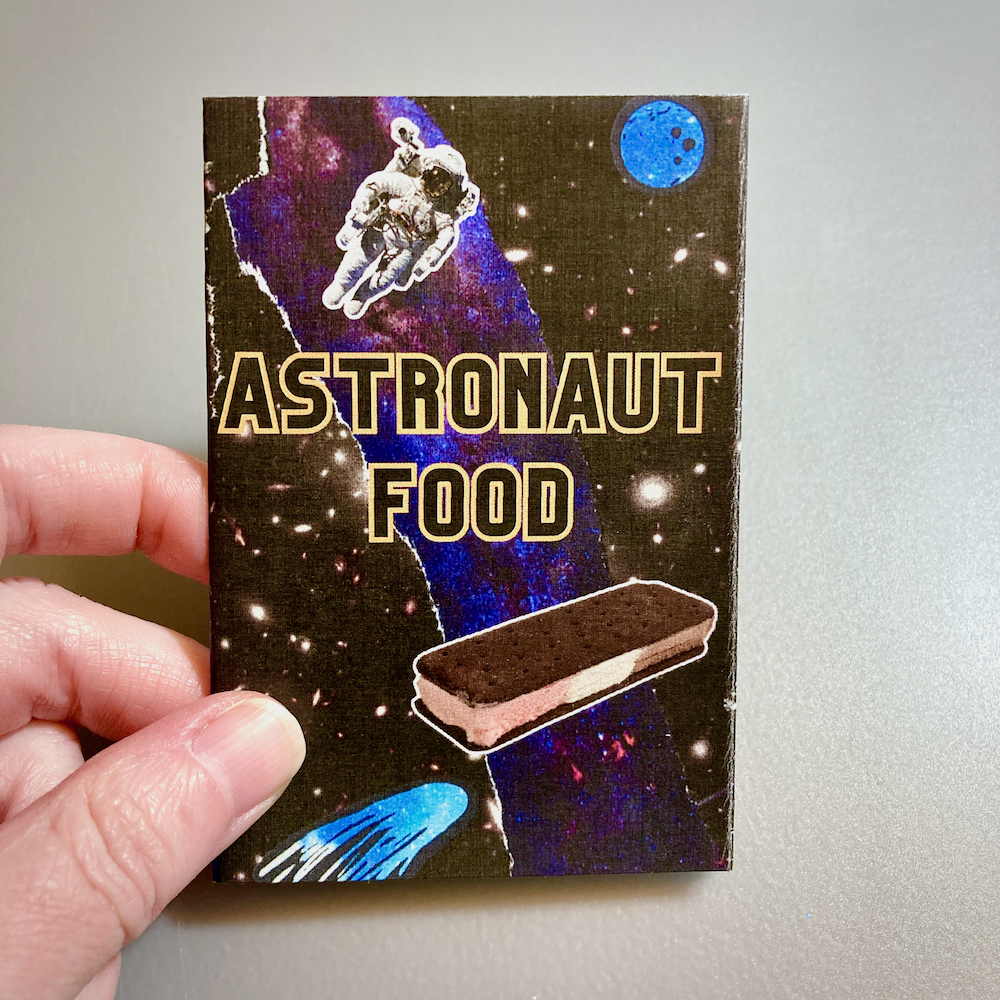
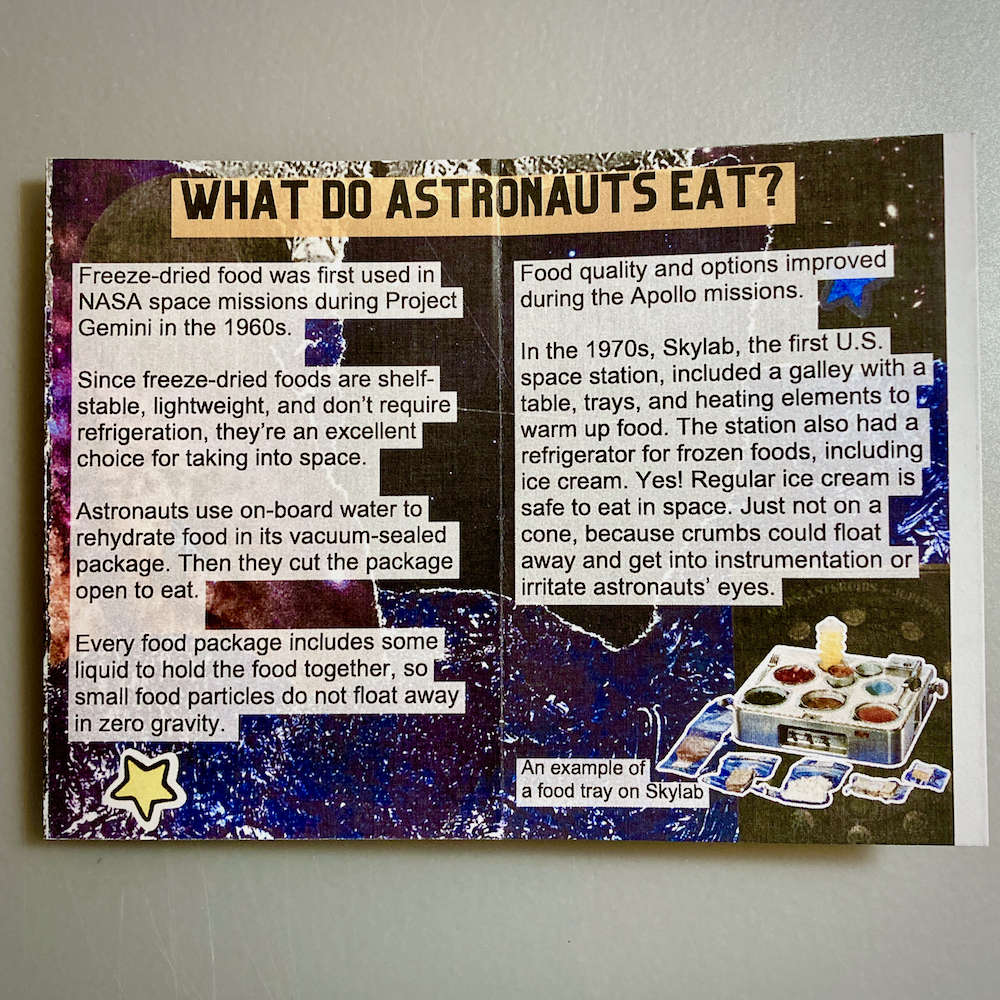
Freeze-dried food was first used in NASA space missions during Project Gemini in the 1960s.
Since freeze-dried foods are shelf- stable, lightweight, and don’t require refrigeration, they’re an excellent choice for taking into space.
Astronauts use on-board water to rehydrate food in its vacuum-sealed package. Then they cut the package open to eat.
Every food package includes some liquid to hold the food together, so small food particles do not float away in zero gravity.
Food quality and options improved during the Apollo missions.
In the 1970s, Skylab, the first U.S. space station, included a galley with a table, trays, and heating elements to warm up food. The station also had a refrigerator for frozen foods, including ice cream. Yes! Regular ice cream is safe to eat in space. Just not on a cone, because crumbs could float away and get into instrumentation or irritate astronauts’ eyes.
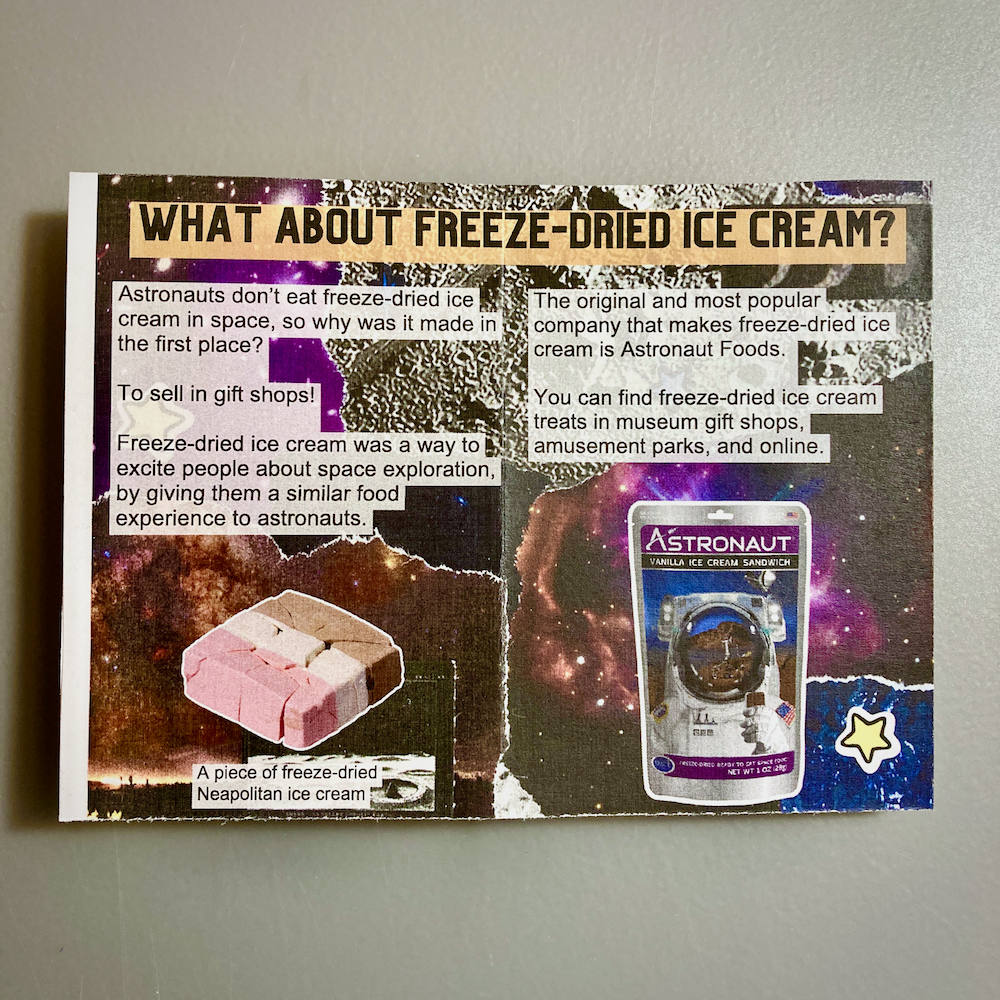
Astronauts don’t eat freeze-dried ice cream in space, so why was it made in the first place?
To sell in gift shops!
Freeze-dried ice cream was a way to excite people about space exploration, by giving them a similar food experience to astronauts.
The original and most popular company that makes freeze-dried ice cream is Astronaut Foods.
You can find freeze-dried ice cream treats in museum gift shops, amusement parks, and online.
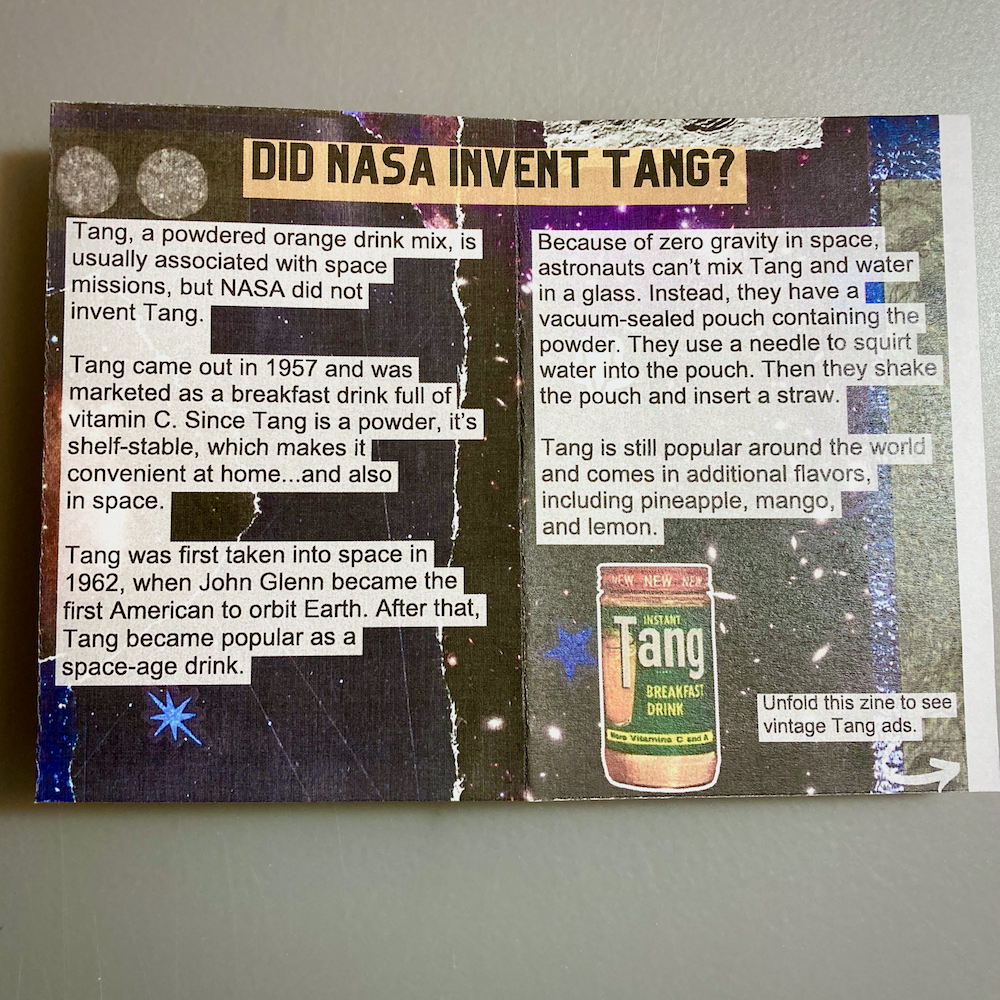
Tang, a powdered orange drink mix, is usually associated with space missions, but NASA did not invent Tang.
Tang came out in 1957 and was marketed as a breakfast drink full of vitamin C. Since Tang is a powder, it’s shelf-stable, which makes it convenient at home…and also in space.
Tang was first taken into space in 1962, when John Glenn became the first American to orbit Earth. After that, Tang became popular as a space-age drink.
Because of zero gravity in space, astronauts can’t mix Tang and water in a glass. Instead, they have a vacuum-sealed pouch containing the powder. They use a needle to squirt water into the pouch. Then they shake the pouch and insert a straw.
Tang is still popular around the world and comes in additional flavors, including pineapple, mango, and lemon.
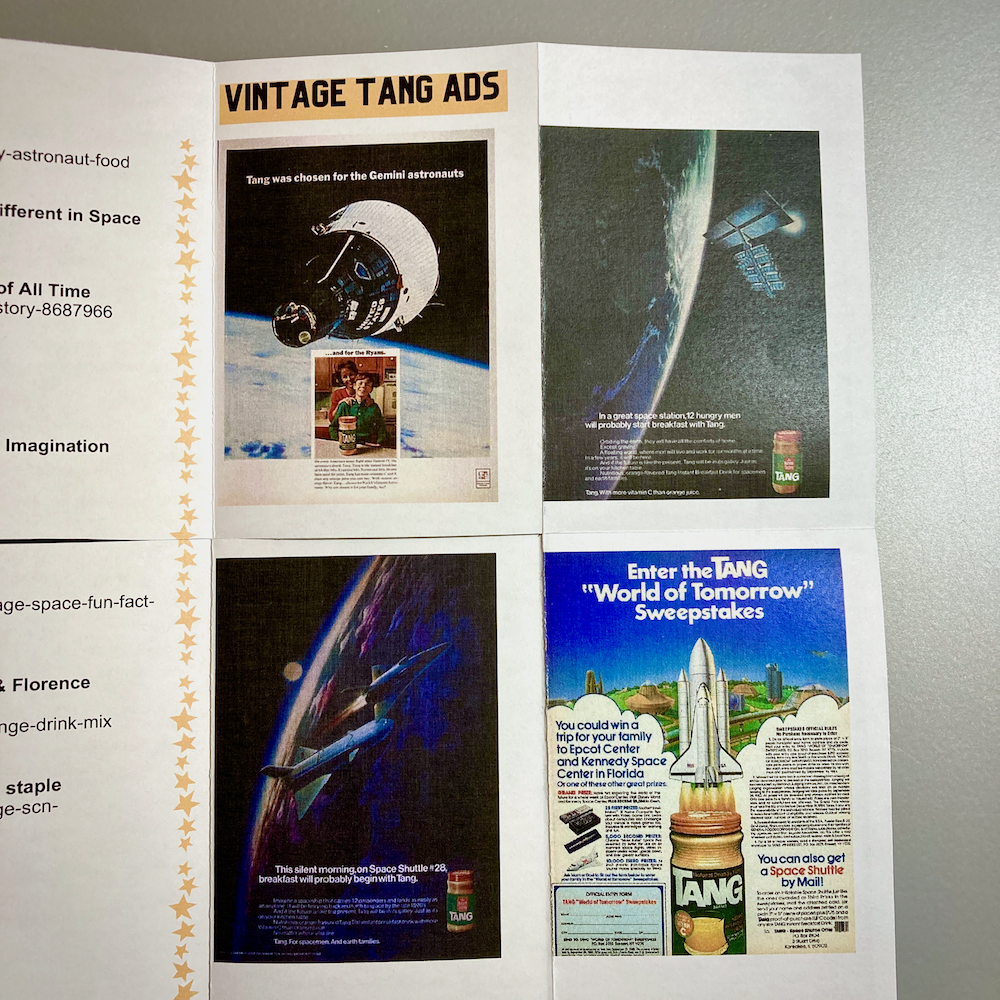
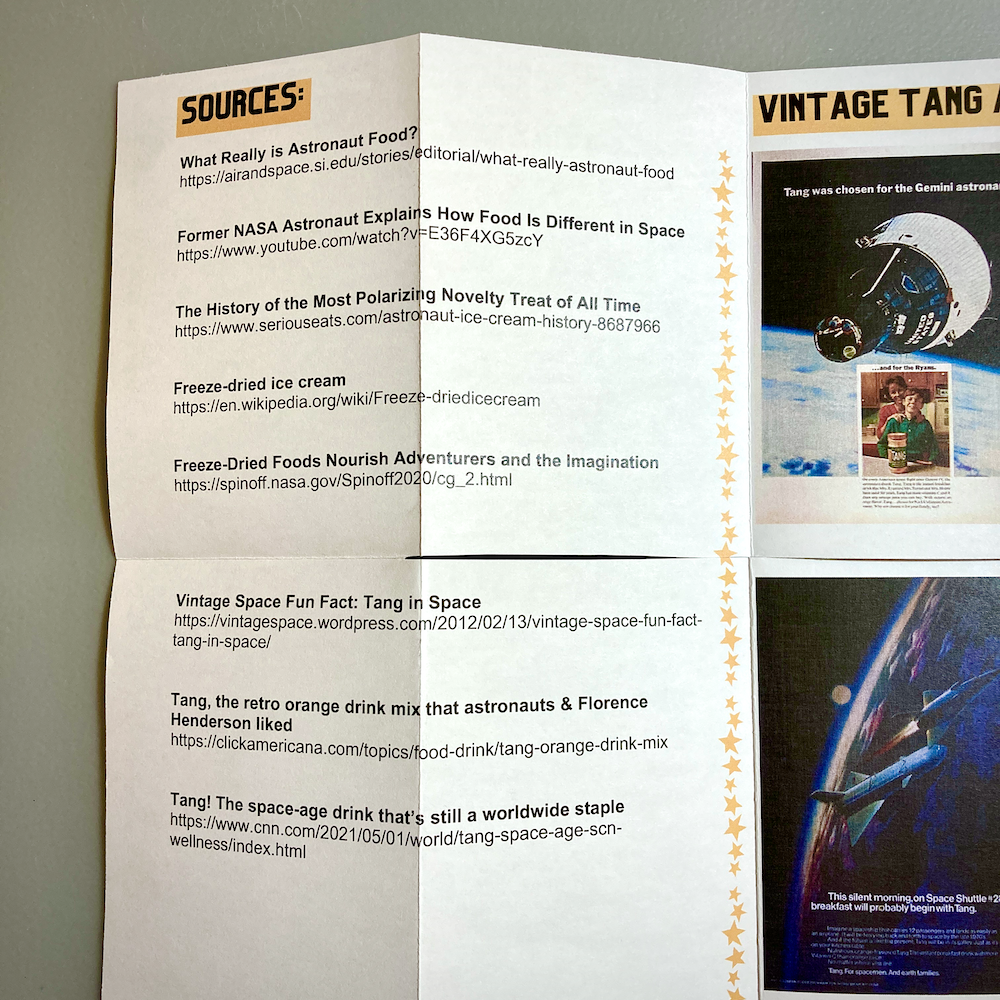
What Really is Astronaut Food?
Former NASA Astronaut Explains How Food Is Different in Space
The History of the Most Polarizing Novelty Treat of All Time
Freeze-Dried Foods Nourish Adventurers and the Imagination
Vintage Space Fun Fact: Tang in Space
Tang, the retro orange drink mix that astronauts & Florence Henderson liked
10/20/24
“Left-brained art” is a mini zine that includes tips for how to make art without having to plan all the details up front. Each page includes a tip and brief explanation.
This zine encourages you to work with the materials you already have and not worry about what people will think of the finished work.
I drew the background by hand with markers. Layout and text in Canva.
Copies are available in my Etsy shop (U.S. only). I’m also open to trading! (Message me.)
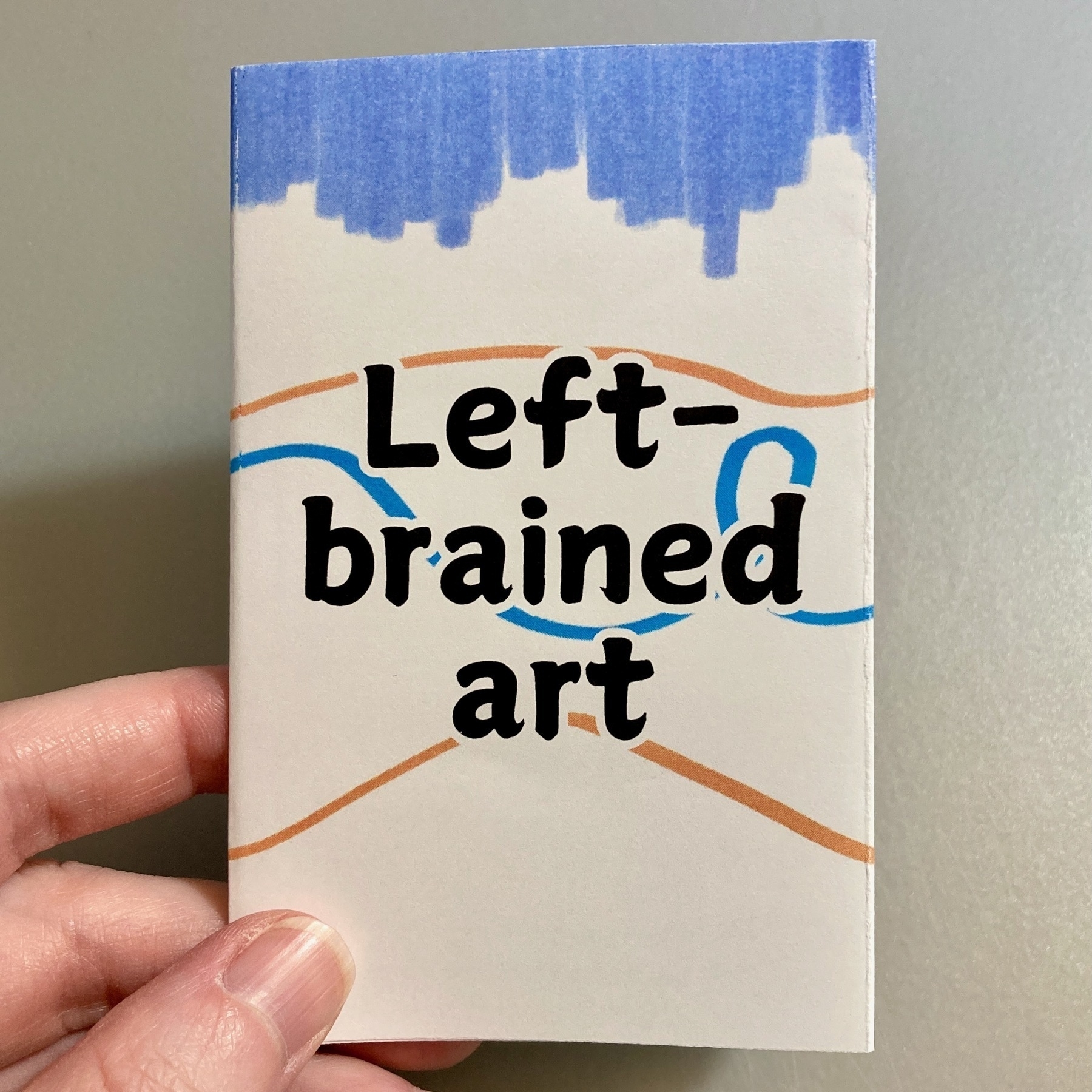
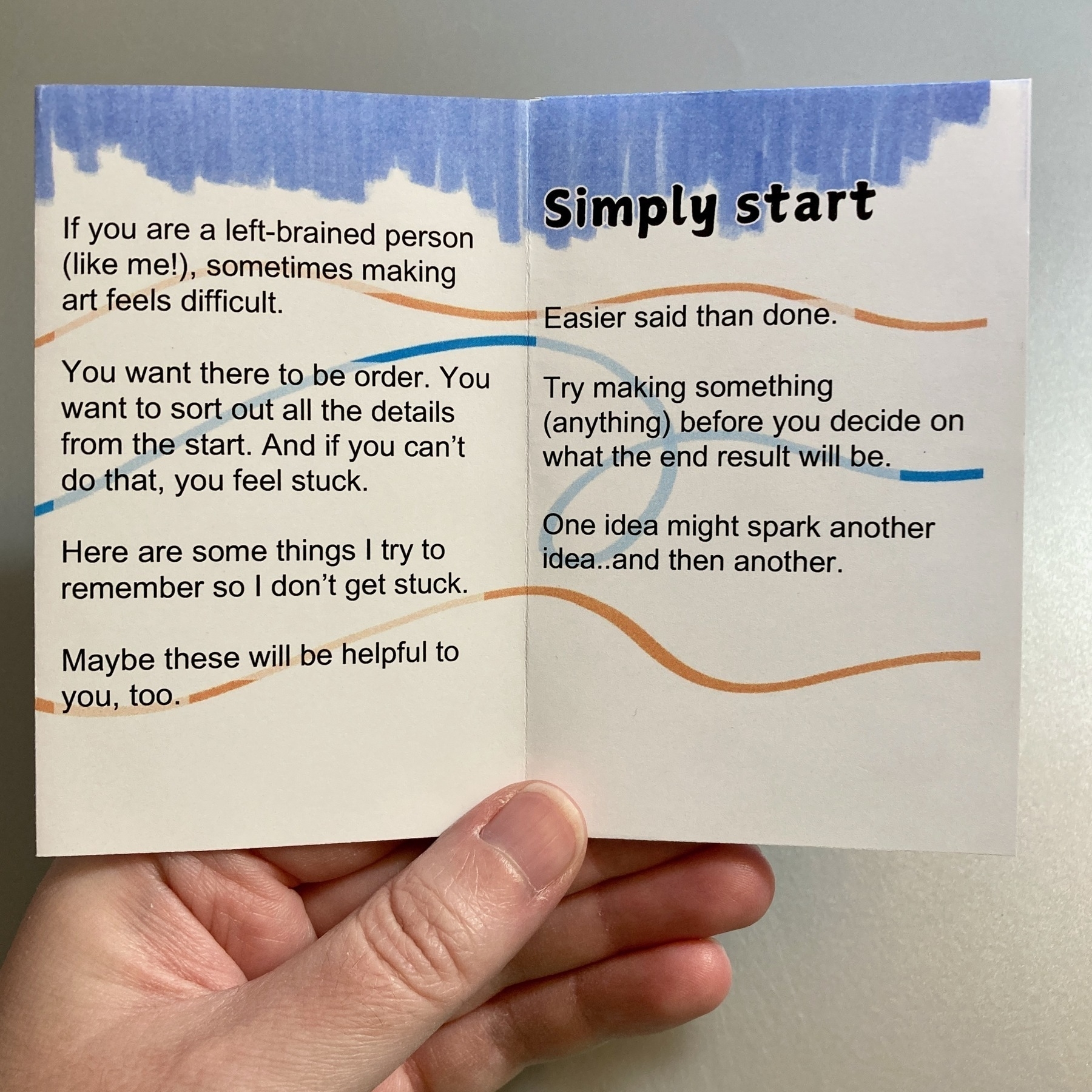
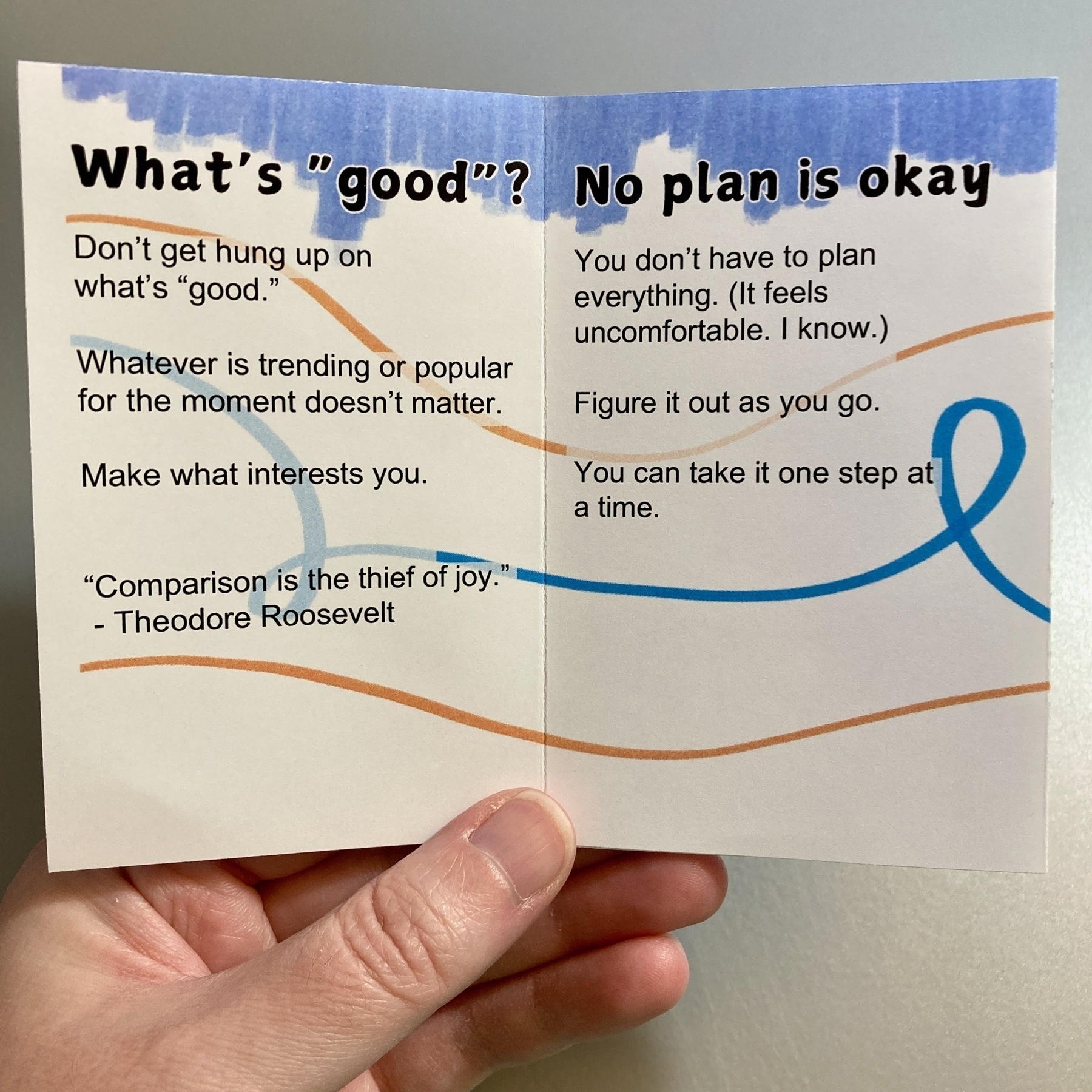
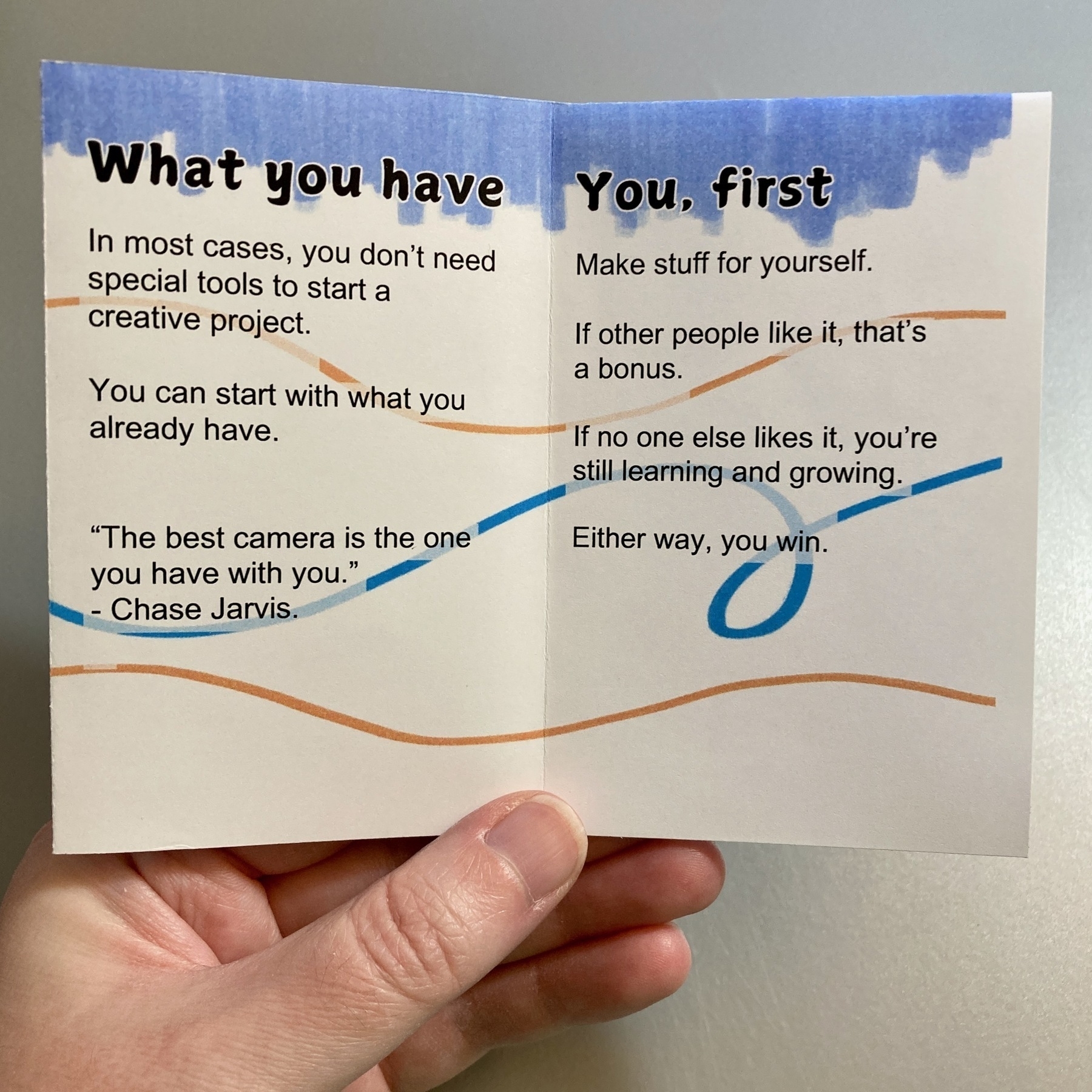
Left-brained art
If you are a left-brained person (like me!), sometimes making art feels difficult.
You want there to be order. You want to sort out all the details from the start. And if you can’t do that, you feel stuck.
Here are some things I try to remember so I don’t get stuck.
Maybe these will be helpful to you, too.
Simply start
Easier said than done.
Try making something (anything) before you decide on what the end result will be.
One idea might spark another idea..and then another.
What’s “good”?
Don’t get hung up on what’s “good.”
Whatever is trending or popular for the moment doesn’t matter.
Make what interests you.
“Comparison is the thief of joy.” – Theodore Roosevelt
No plan is okay
You don’t have to plan everything. (It feels uncomfortable. I know.)
Figure it out as you go.
You can take it one step at a time.
What you have
In most cases, you don’t need special tools to start a creative project.
You can start with what you already have.
“The best camera is the one you have with you.” – Chase Jarvis
You, first
Make stuff for yourself.
If other people like it, that’s a bonus.
If no one else likes it, you’re still learning and growing.
Either way, you win.
9/15/24
Yesterday I ran a zine-making station at a public library fundraiser. 🙂
The library had a Fall Fair with a bake sale, raffles, magic show, and games. Arts and crafts tables were inside the library. Here’s the zine-making station.

The library provided magazines, scrapbook paper, markers, glue sticks, scissors, and plain white paper. I brought copies of How to make a mini zine and What’s a zine?
This is the first time I’ve done a zine event with kids. Having collage materials definitely helps, so kids don’t have to write something on the spot.
Two girls spent about an hour and a half at the table, making two zines each, because they said they were having so much fun. 🥹
I think if I do more kid-focused zine events, I might make some kind of template that they can fill in. Having more of a guide might be a nice option besides having a blank piece of paper.
Here’s a zine I made during some downtime.





8/12/24
“What’s a zine?” is an 8-page mini zine that you can download and print on your own. It includes a brief introduction to zines: what zines are, some historical highlights, and common formats.

The zine is available on Ko-fi for free (or pay what you want).
The PDF is sized to print on one sheet of 8.5 x 11-inch paper (standard U.S. letter size).
This zine is licensed under Creative Commons (CC BY-NC-SA 4.0), which means you’re welcome to distribute and share copies for non-commercial use.
If you don’t know how to fold this kind of zine, search for “how to fold an 8-page zine” on YouTube to find tutorials.
6/24/24
“So You Met Your Past Self” includes tips for what to do when you meet a past version of yourself. This fictional zine is a handy guide for the time traveler in your life (even when that’s you).
This zine is available on Etsy (U.S.) only.




I made the background for this zine by hand. I diluted blue fountain pen ink in water. Then I painted the ink on to watercolor paper.

After the paper dried, I drew an abstract design with a dark blue marker and white gel pen.

This kind of line drawing is a technique I learned from Katie Gebely.
First you draw dots on the page, at random. Then you connect the dots with straight lines. That’s what I did with the dark blue marker. Then I added shorter lines in white gel pen.
5/19/24
“How to make a mini zine” is an 8-page mini zine that you can download and print on your own. It includes a brief introduction to zines and instructions for how to fold an 8-page mini zine from a single sheet of paper.

The zine is available on Ko-fi for free (or pay what you want).
The PDF is sized to print on one sheet of 8.5 x 11-inch paper (standard U.S. letter size). No access to a color printer? No problem — the zine looks great in black and white, too.
To fold the zine, you can follow the instructions directly on the PDF. Or if you prefer video instructions, search for “how to fold an 8-page zine” on YouTube.


This zine is licensed under Creative Commons (CC BY-NC-SA 4.0), which means you’re welcome to distribute and share copies for non-commercial use.
5/14/24
“The antidote to social media” is a mini zine that looks at how negative things are outweighing positives on social media. But social media platforms are still a good way to find people to connect with. The zine suggests ways to work around the negative aspects of social media.

Copies are available on Etsy (U.S. only).



A lot of my zines start in a notebook page. Here’s where I started writing out what I wanted to include in this zine.

1/7/24
“Useless Venn Diagrams” is a mini zine with random observations, put into Venn diagram format. Topics include puzzles, note-taking, and movies.
Printed in black on teal paper. I drew this zine by hand and then adjusted spacing and layout in Canva.




12/19/23
“Cat’s Cradle” is a tiny story about mimicking someone. It’s not quite sci-fi, but it feels like it…maybe because it was inspired by a scene near the end of Annihilation. (I won’t spoil the movie and neither does the zine.)




Here’s the full text of the story:
It’s like playing cat’s cradle, but we aren’t using string.
I do one thing. She does something else that feels like… an extension. A continuation.
And then we swap.
She does one thing— says a phrase, draws some lines, moves her arm just so.
I extend— a line of poetry, a floral doodle, a yoga pose.
And then we swap.
The training protocol doesn’t specify how to teach. Just that I’m supposed to.
I report progress back to the team.
And then we swap.

10/22/23
“Modern-day Sisyphus” is a mini zine about 21st century tasks that never go away.
The zine is inspired by Sisyphus, a figure from Greek mythology who is tasked with rolling a boulder up a mountain, only for the boulder to roll back down every time he reached near the top.
Copies are available on Etsy.

Page 1 has a summary of the story of Sisyphus.
Page 2 lists chores that are repetitive: washing dishes, doing laundry, dusting, and vacuuming. At the bottom of page 2, there’s an illustration of a man rolling a boulder up a hill.

Pages 3 and 4 list tasks that are repetitive: making the bed, replying to emails, mowing the lawn, taking out trash, and paying bills. At the bottom of the pages, there’s an illustration of a man rolling a boulder up a hill.

Pages 5 and 6 list positive things that are repetitive: listening to favorite songs, making a cup of coffee, saying good night to loved ones, cooking favorite meals, celebrating holidays, and spending time on hobbies. At the bottom of the pages, there’s an illustration of a man rolling a boulder up a hill.

Here’s the back cover:

8/9/23
“Song lyrics I mishear” is a mini zine that lists lyrics where I hear the wrong words. Each page is about one song and includes the actual lyrics along with what I hear instead.
I wanted the interior pages to be a mix of typed text (the actual song lyrics) and handwritten notes (the words I hear). This way, the pages look like they’re annotated.
Copies are available on Etsy.





6/24/23
I’ve been particularly annoyed lately about how much we depend on cars, so I made a little zine about it. I’m not saying we should eliminate cars completely. I want better public transportation so everyone has more and better options for getting around.
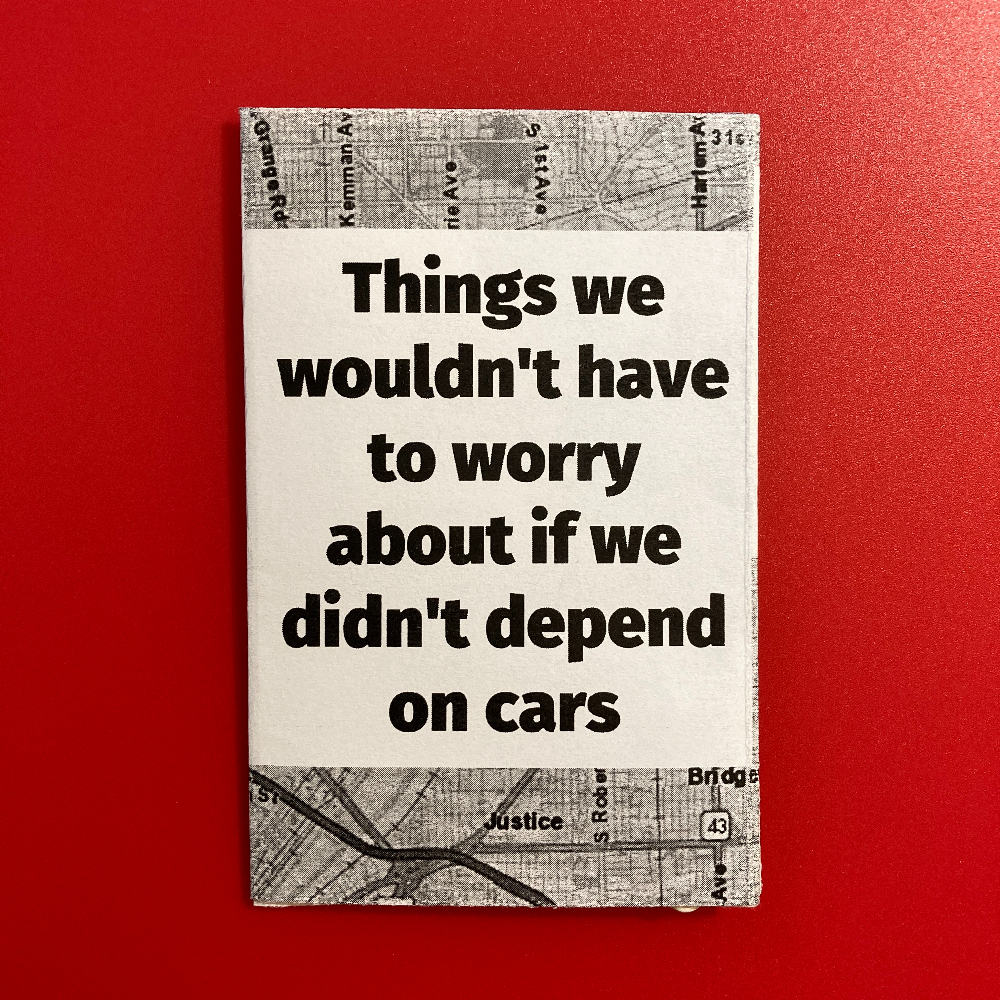
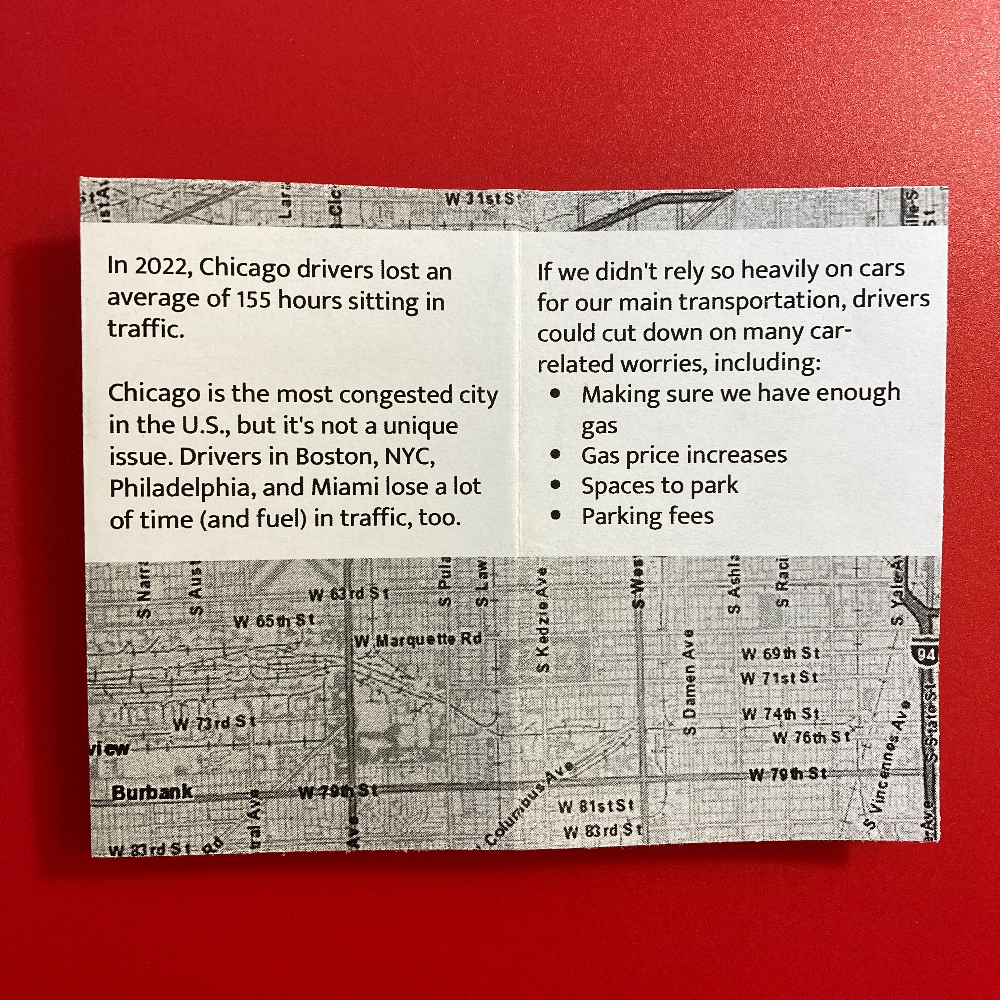
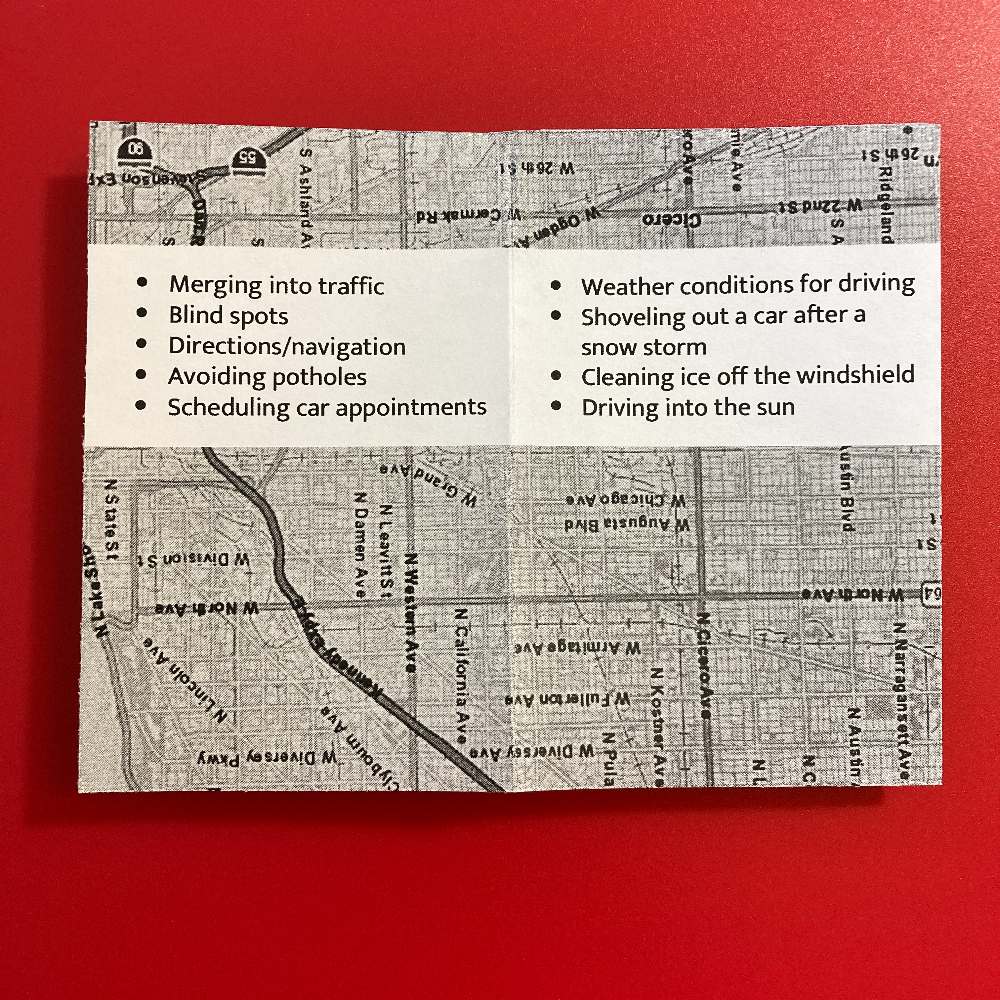
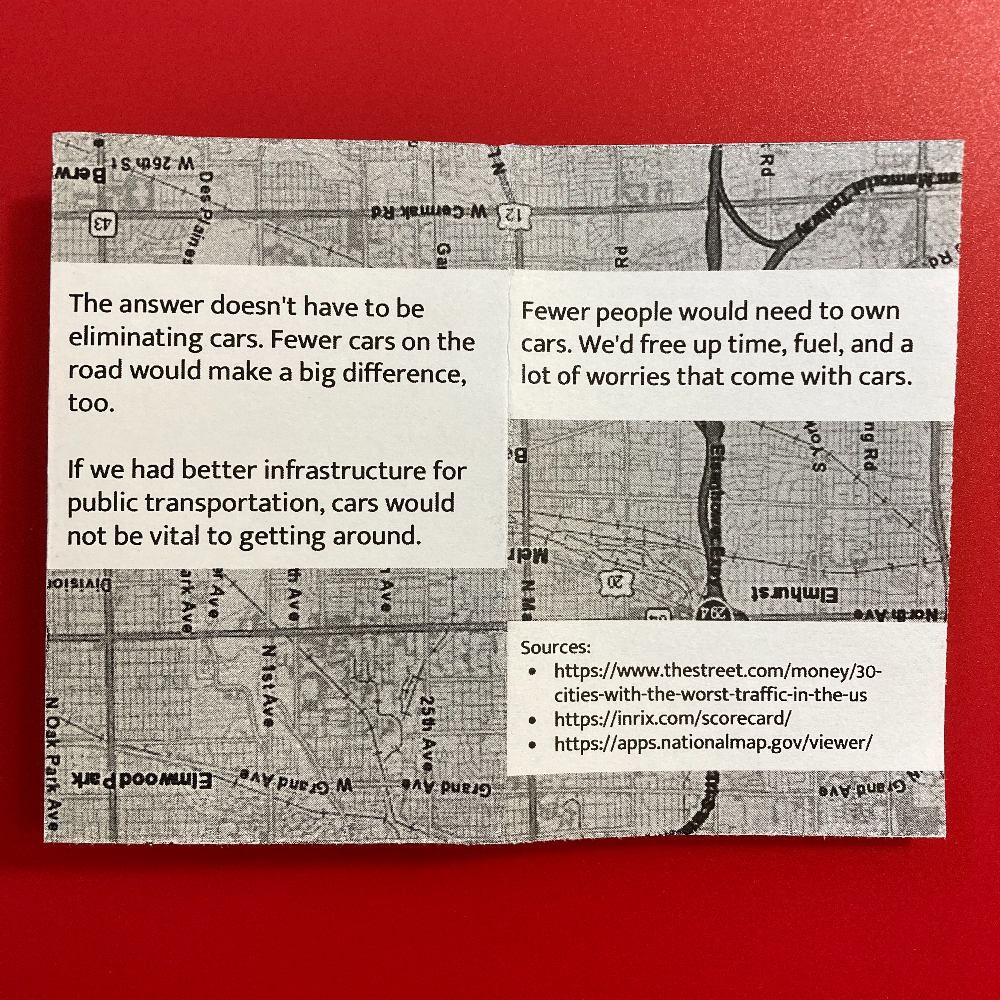
5/11/23
“Playground games in the 1990s” is a pros and cons list of recess activities that were popular in elementary school. (At least in central Pennsylvania, in the 1990s.)
Each page includes small illustrations relating to playground activities. I drew on Whitelines paper so I could draw with a regular pen and then photograph the paper to use the drawings digitally.





3/6/23
“Movies I never want to see again” is about movies I watched one time and do not want to watch again. This doesn’t mean they’re bad movies! But something about them makes me feel like once is enough.
I drafted this zine by hand and then I made it in Canva. The popcorn bucket on the front cover is modified from Terrance Barksdale’s photo on Pexels.





2/2/22
“Everyday Time Travel” is about ordinary moments that feel like time moves differently than normal.

Out of the zines I’ve made so far, this one probably came together the fastest, from the initial idea to the finished zine.
I made the backgrounds with scrapbook paper, and I added some details with fineliner pens. Then I wrote the text on white paper, tore out pieces, and glued them over the scrapbook paper. I like how all the colors and patterns came together.
Here are the interior pages:



And the back cover:

1/1/22
“Questions to ask yourself: Part 3” is a hand-drawn mini zine with thoughtful questions and illustrations.



This is part 3 in a series.

1/17/21
“How to teleport safely” is a handy (fictional) guide for how to use teleportation devices safely and avoid…incidents.




1/16/21
"Text Message Moods" illustrates what text message conversations look like, depending on people's moods. You may recognize these patterns.
Copies of this zine are available in my Etsy shop.




12/30/20
More questions with no real answers. This is part 2, with a different style of questions.




12/30/20
Some questions with no real answers, but maybe they offer some introspection.




12/29/20
A black and white zine with a simple encouragement.




11/28/20
I have some sample fountain pen inks from The Goulet Pen Company that are colors I would not write with, but they are definitely colors I would draw with. A bright yellow ink reminds me of caution tape, so I created this zine of everyday dangers, with the danger highlighted in yellow on each page.





11/8/20
I wanted to do a space and sea theme for a while, but I was stuck on the words. And then NASA found water on the moon.
I love how the colors, text, and illustrations came together. If you want to read about my process for this zine, keep scrolling after the images. 🙂





I started with a white sheet of cardstock and used blue and black stamping inks to build the background colors.
The blue ink is distress oxide ink, so it reacts with water. After the blue and black inks dried on the page, I sprayed the blue area with water and used a clean brush to move the water around and add some texture. Then I let it dry completely. I drew the seaweed and everything else in the blue area with Tombow dual brush pens.
I drew the stars and moon in the black area with a white gel pen.
To create the text, I used a Phomemo thermal printer with sticker paper.
10/18/20
A zine about how I make zines. So meta!





If I don't quite know what I want to write or draw, I plan out the zine on one page, like so:

This acts as a rough draft of my zine, so I can sort out what I want on each page.
I like to work on zines with the page unfolded, so I use small sticky notes to label each page, like this:

This lets me work on pages in whatever order I want, without losing track of the order in the folded zine. And, having the page unfolded means I don't have to worry about ink bleeding through to another page.
10/18/20
This is a little story about telepathy...or something like it.





9/26/20




9/14/20
A handy little zine for how to identify potential time travelers.





To make the background for this zine, I started with white cardstock paper. I used distress oxide inks (3 shades of blue) and blended them on the paper with a sponge applicator. This ink reacts with water, so I used a gear stencil and traced the gear shapes with a brush and plain water. That's what made the sort of ghost-looking gears. I used watercolor brush pens with the stencil to create the darker blue and purple gears. The blue and orange clock faces (most of the cover page and the clock faces on the inside pages) are scrapbook paper that I happened to have and fit perfectly. :)

9/12/20
“So You Met Your Doppelgänger” is a hand-drawn mini zine printed on an 8.5"x 11" sheet of paper and hand-folded. The finished zine is 8 pages and approximately 4.25 inches x 2.75 inches.
This fictional zine is a handy guide for what to do when you meet your doppelgänger (whether they’re a clone, from an alternate universe, or a time traveler).
This is my most popular zine! You can read it below. Physical copies are available to purchase on Etsy.




6/27/20
My inspiration for this zine came from my freshman year of college. The women who lived in the dorm next to me were both radio DJs and often had music blasting in their room. I didn’t mind—they had great taste!—and I found lots of songs I like through them.
The idea of finding music you like through people around you expanded into the pages of this zine.
I tried something new for me—monochrome. Only gray and black pens and markers in this zine. I like how it turned out.



